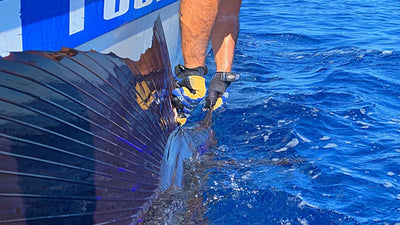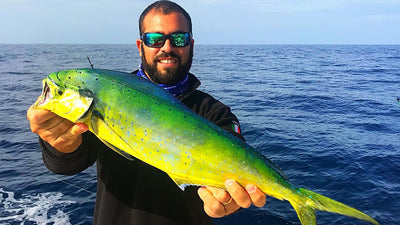When talking about deep sea fishing, we often find ourselves faced with choices to make, for example regarding the setup, the areas, the bait, which could determine the success or failure of a fishing trip... and when our objective is precisely the imperial garfish, the doubts could increase drastically, when instead it would be enough to take into account some guidelines to be able to say at least that we have fished in the right way.
While it is true that in the high seas you go in search of large pelagic fish, it is equally true that not all these predators behave in the same way, both in terms of migratory routes and places of aggregation, and in terms of the way they attack our baits and subsequently react to a strike. Wanting to make an example with "names and surnames", we cannot equate the hunting areas of albacore and those of imperial garfish , just as their fight is completely different. And so, even if it is not always an easy choice, if our dream is to catch an imperial garfish, we will have to be willing to put aside the idea of fishing "what comes", to concentrate on our objective, even at the cost of returning to port with a few coats before hitting it.

Bathymetric
Let's start with a topic of fundamental importance, because the first action to take as soon as you leave the port will be to turn the bow towards a fishing area. But, it is worth repeating, the imperial garfish usually hang out on rather low bathymetrics . It is therefore useless to go looking for them at 1000 or 2000 m of depth, when perhaps we have interesting areas within reach in the 100/200 m range. Let's therefore concentrate on depths that oscillate between 70/80 m up to 400 m... on these bathymetrics in fact not only will an encounter with some passing specimen be more likely, but we could also be so lucky as to find any areas in which the imperial garfish usually congregate for reproduction or even just to rest during migration.
Baits and rigs
We know that we can find all types of bait on the market, but even if it seems obvious, it is worth repeating that not all of them can be suitable for specific fishing for the imperial garfish . A good bait, speaking of kona obviously, must first of all work in the right way, emerging at the surface of the water to take in or capture air, and then diving again leaving a trail of bubbles behind it. But in addition to the work done by the baits, their size also plays a fundamental role, since in some moments of the year the imperial garfish can be more inclined to attack small-sized baits, while in other periods instead, considering the forage present, they will prefer baits of a certain size , even 30 or more cm. If in doubt, before starting to learn the behavior of these fish in our area, we can use baits of different sizes, and then replace the others after any strikes. Even the position of the hook inside the kona could mean the difference between a good catch and a departure that ends with an unhooking. In fact, our trap must be placed at the furthest point possible, coming out of the skirt for the entire length of the shank, and the double hook rig must absolutely be avoided .
Best Kona for Imperial Garfish
If we want to mention some deadly baits for imperial garfish, we must necessarily mention the Jet Monkey and the Cube among the small ones, and the Spearfish Master and Albacore Tube talking about larger sized baits. Even the Bullet , small and thin, gives incredible results in flat sea conditions... proving to be certainly very catchy, but less versatile than the Jet Monkey and the Cube. As for the Spearfish Master, it sees its best use in very rough seas, especially if lined long on the shot gun. And since colors also play their fundamental role , let's remember that this predator loves shades of purple and black, not disdaining green and red/white.

Setups and speed
Once we have identified a valid area and prepared the baits, all we have to do is spin them out to fish. In this case, we will have to be very careful to observe the wake and the waves that the boat causes, because the baits should preferably be positioned immediately before small waves, so as to be at an advantage in carrying out their work. Contrary to what is thought, imperial garfish do not need long-spun baits , on the contrary they tend to approach the boat attracted by the noise and foam of the engine . Precisely for this reason we can choose a set-up that covers different distances, but between 15 and 60 meters, which also plays to the advantage of the kona, which with little line in the water are able to carry out their sinusoidal movements better. But it is not only the distance from the stern that makes a kona extremely captivating, but also the trolling speed . In fact, most Kona boats are designed and engineered to perform at their best in a speed range that usually doesn’t go below 6 knots, but without fear of going beyond 8 knots.

Combat
After the strike, the fight with an imperial garfish should be done differently than with other fish in the Mediterranean. Even if it is not a very common practice in our waters, in addition to clearly depending on the size of our prey, slowing down the boat and recovering all the other lines could sometimes be decisive in avoiding possible tangles and loss of the fish. The imperial garfish moves quickly on the surface of the water, continuously changing direction, making rapid starts and acrobatic jumps. All conditions that could cause an unhooking, perhaps after having already anticipated a souvenir photo... And then, helping yourself with the boat to recover line to shorten the distances and avoid useless bellies of line, is certainly the way to go when you have an imperial garfish of a certain size on the rod. Then, when the fish is now 30/40 meters from the boat, we can pump with the rod, always alert to maneuver during possible changes of direction or very close jumps.

The perfect release
Billfish are very delicate fish, even if it doesn't seem so! It often happens that a fish is handled excessively, perhaps holding it by the bill even during the early stages, when struggling forcefully it risks causing trauma, or could even impact against the hull of the boat. These fish, unfortunately, if released will be destined for almost certain death. A conscious release aimed at effectively safeguarding the animal's health should be carried out without touching the prey in the slightest , but only trying to remove the hook with the aid of special long-nosed pliers or with gloves. In extreme conditions where removing the hook is excessively difficult, you could consider cutting the leader, keeping only the bait and effectively losing the hook and the rig.
When he chases but does not attack
It will certainly have happened, or undoubtedly will happen, to see the fish chasing our baits, without launching the decisive attack. In these cases, let's always remember that we are using artificial baits that, as such, need movement and speed to be attractive. From here comes the consequence that stopping the boat and then starting again in the hope of stimulating an attack, will not be the best choice. A valid alternative, however, could be to remove the rod from the rod holder behind which we saw an imperial garfish, and jerk quite energetically. This practice could stimulate the predator's aggression, which by attacking our bait will also find itself receiving a possible first strike, in addition to that given by the same boat that moves at speed ... without considering the fun of receiving a strike having the rod in hand!








Salve, avrei bisogno di un consiglio: quando vedo l’aguglia imperiale rincorrere senza attaccare, potrebbe essere utile decelerare con la barca? Grazie